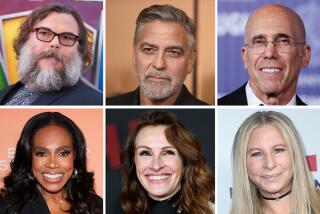Book review: ‘Hollywood Left and Right: How Movie Stars Shaped American Politics’ by Steven J. Ross
Hollywood Left and Right: How Movie Stars Shaped American Politics
Steven J. Ross
Oxford University Press: 512 pp., $29.95
Republicans take heart: Hollywood is not as liberal as you think. Steven J. Ross convincingly shows in “Hollywood Left and Right” that since its early days, the movie industry has been as quietly conservative as publicly liberal. After all, where did Ronald Reagan come from?
Reagan may be the most successful actor-turned-politician, but Ross makes the case that his transition owes much to George Murphy and the conservative legacy built by Louis B. Mayer at MGM. Mayer was an up-from-nothing immigrant who became a titan ruling Hollywood’s grandest studio back when the studio system was Hollywood. He also turned his ambitions to politics: He was chair of the California Republican Party, and his friendship with Herbert Hoover led him to be the first Hollywood executive to spend a night in the White House. He had no compunctions about combining work and politics: He brought on executive secretary Ida Koverman, who served as a political tutor and liaison, and he required MGM staff to contribute to the causes he chose. His efforts nurtured the thinking and political career of Murphy, who became head of the Screen Actors Guild and U.S. senator and in turn served as mentor to Reagan, who went from heading SAG to governor of California and president.
Ross combines biographical sketches with detailed political history of 10 Hollywood figures, five left and five right, to show that the dream factory has been equally devoted to politics on both sides of the aisle. He moves chronologically, beginning with Charlie Chaplin (left) and following with Mayer (right), Edward G. Robinson (left), Murphy (right) and Reagan (left to right), Harry Belafonte (left), Jane Fonda (left), Charlton Heston (left to right), Warren Beatty (left) and Arnold Schwarzenegger (right).
“They were leaders, not just followers. They did not simply bask in their fame and wealth; they worked as hard at their politics as they did at their screen careers,” Ross writes. “They fit the Founding Fathers’ model of citizen-statesmen in that they had a vision of the world they wanted to see and they were willing to work to usher in that change. And for that, they deserve our respect.” It may be a challenge to get those who respect Reagan to do the same for Jane Fonda and vice versa but Ross lays out their work and lives fairly, doing his best to keep a level playing field.
Ross has previously published a book on silent film and politics; he shows how Chaplin, an early box-office king, became drawn into politics to the detriment of his career. Digging into the unpublished manuscript of Chaplin’s onetime assistant, Ross writes that Chaplin, who had to drop out of school as a child to become a street performer, was an anxious yet eager autodidact. His films show an increasing political awareness, beginning with sympathy for the poor and disenfranchised and moving to 1940’s “The Great Dictator,” which mocked a fictional, Hitler-like fascist ruler. Americans were reluctant to embrace his satire, and his wartime speeches that supported then-ally Russia were used to criticize him later, along with his protests against the nuclear bomb (his many marriages to very young brides didn’t help). He was among the high-profile Hollywood names bandied about by the anti-Communist House Un-American Activities Committee, and in 1952, when the British-born Chaplin traveled to London, he was charged with being a Communist. He didn’t return to the United States for 20 years.
Robinson also suffered at the hands of HUAC. When he was a boy in Romania, his brother was beaten to death by an anti-Semitic mob, prompting the family to emigrate to the U.S. Growing up poor in New York, Robinson found his place in Hollywood, starring as the lead gangster in 1931’s “Little Caesar” and becoming one of its hottest stars. In the ‘30s and ‘40s, he was an outspoken anti-fascist, and he put his money where his mouth was — more than a quarter of a million dollars from 1939 to 1949, roughly $3.1 million today. His association with one anti-fascist group, which became known for its communist ties, as well as anti-red-baiting stance had him called a Communist during HUAC testimony, generating so much acrimony that he couldn’t find work. He spent three years fighting the charges, eventually caving in and appearing as a chagrined witness before HUAC and writing an article, “How the Reds Made a Sucker out of Me.” His career never recovered.
Those who’ve read histories of the Red Scare in Hollywood like Victor Navasky’s “Naming Names,” thorough explorations of Reagan’s political evolution or other investigations of these periods may be frustrated by the gloss Ross takes. While his book is extensively footnoted and deeply researched, a lot of context is lost. Of course, he’s covering a century of history through 10 individuals, which is a lot to fit into 500 pages. Yet if all politics is local, it is also personal and temporal. The personal gets a solid treatment, yet there is not much larger perspective on social movements outside of those the individuals touched, the social environments in which they made their choices, or the larger historical contexts.
This is at its worst in explaining the importance of Heston, in his role as head of the National Rifle Assn., and the 2000 election. “Pundits credit gun owners in West Virginia — where Democrats outnumbered Republicans two to one — with tipping the state and therefore the presidential election in 2000 to George W. Bush. Rarely has a movie star had such a profound importance on national life,” Ross writes. Nowhere in the chapter does he mention the role of Florida’s recount or the Supreme Court in the election’s final result.
If there is a theme, it is that activist leftists in Hollywood have often leveraged their professional positions to create artworks that support their ideology: Belafonte, Fonda and Beatty all became producers as well as stars. Often this worked to their financial benefit, but not always. Those on the right — Murphy, Reagan, Heston and Arnold Schwarzenegger — tended to use the lessons they’d learned from appearing on screen and having a public Hollywood life to build a second act in politics. These conclusions, however, are left to be drawn by the reader. Ross is excellent at providing details, but he never quite figures out what they mean; he never draws back to provide the big picture.
More to Read
Sign up for our Book Club newsletter
Get the latest news, events and more from the Los Angeles Times Book Club, and help us get L.A. reading and talking.
You may occasionally receive promotional content from the Los Angeles Times.











